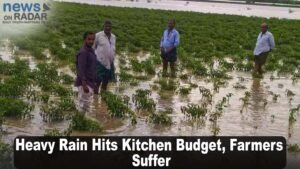Churu The monsoon rains, though a lifeline for farmers, have taken a toll on the everyday household budget. Unseasonal and heavy rainfall in many parts of Rajasthan, including Churu, has disrupted vegetable supplies, sending prices soaring and making the humble Indian meal costlier and less flavorful.
For local families, the rising cost of vegetables has made it increasingly difficult to maintain a balanced diet. Staples like tomatoes, onions, and green chilies — once found in abundance — are now being sold at nearly double their usual prices. As a result, the flavor of the traditional Indian thali has faded for many, both in terms of taste and affordability.
Farmers and vendors are both bearing the brunt of the erratic weather. In the nearby vegetable mandi (wholesale market), traders report a significant drop in both supply and demand. “Sales have dipped by 30 to 50 percent,” said a vendor in Churu. “The vegetables we do receive are coming in poor condition due to rain damage, and customers are cutting back because of the high prices.”
This dual blow has created a crisis for small-scale farmers, many of whom were already struggling with rising input costs and uncertain market prices. For them, the rain has not just damaged standing crops but also delayed harvesting and transportation, leading to spoilage and losses.
“We barely managed to harvest the crop before the downpour ruined the rest. The ones that survived are too wet and rot quickly during transport,” shared a distressed farmer from a nearby village. “The mandi rates are falling even as retail prices rise. It’s hard to understand how we’re losing money while customers are still paying more.”
Consumers too are adjusting their shopping habits. Many households are reducing the variety of vegetables they purchase, opting instead for cheaper and longer-lasting alternatives like potatoes or seasonal gourds. Some are even skipping fresh produce altogether and turning to processed or frozen options.
The price surge has impacted street vendors and small eateries as well. “Earlier I used to prepare 5–6 sabzis daily for my food stall. Now I can afford only 2–3. Customers notice the change,” said a local food seller, adding that profits have dropped alongside customer satisfaction.
Experts believe the situation could persist unless weather conditions stabilize and supply chains return to normal. There is also a growing demand for government intervention, such as temporary price controls or direct aid to farmers, to ease the burden on both ends of the supply chain.
As climate-related events become more frequent, farmers and consumers alike are grappling with the reality that the cost of food is no longer dictated solely by markets, but increasingly by the sky above. For now, a simple meal has become a luxury for some, and a challenge for many.

Comments are closed.